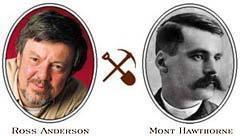
CHILKOOT SUMMIT, ALASKA - To get up here from down there, you start early. Preferably before dawn. Except that in the northern summer, there is no dawn, only a gray dusk that lingers through the night and segues into tomorrow.
So we start at 6 a.m. "We" being an accidental assemblage of humanity who have met at a trailside camp 12 miles up the Chilkoot Pass.
We are an Anchorage historian with her 16-year-old son. We are a couple in their 40s, geologists from Southern California. We are a middle-aged accountant from Vancouver, B.C., on a weeklong jaunt with his 10-year-old son named, appropriately, Dawson.
We are a group of 10 Czechs, mostly from Prague, including a skinny fellow with a beard who carries a full-sized guitar strapped to his backpack, two older fellows who march along with ski poles, and a 60ish woman named Lida with sparkling gray eyes and calves of Slavic iron.
And we are me, a burned-out political columnist traveling with a tattered copy of the stories of the late Mont Hawthorne, Klondiker extraordinaire.
The common denominator is Chilkoot Pass, best-known route to the Klondike gold fields, whose centennial we will observe with the toughest physical challenge many of us have undertaken in years - if ever.
The Czechs are first out of camp. They nod farewell and tromp off with a clatter of ski poles and thick-soled boots. The rest of us fall into place.
From Sheep Camp, the trail wanders briefly alongside the upper Taiya River. Here and there, hidden in the tangled undergrowth, are rusted traces of the tent city that sprouted here 100 years ago and then disappeared almost as quickly a year later.
All too soon, the trail lurches upward, past the tree line and onto snow fields alternating with rock piles. The trail becomes no trail at all, but rather a series of markers - rock cairns erected by rangers, or orange PVC pipe jammed into crevasses.
The going gets tough. At one point, I'm struggling to keep my footing on snowfields, listening for the telltale gurgle of water that indicates thin snow. A few feet higher, I'm lifting an aching leg to a rocky step carved by the boots of a thousand predecessors, gripping a clammy ridge of basalt for support.
The real ascent is yet to come.
After two exhausting hours and a liter of water, I stagger over a rocky ridge to The Scales - so named because this is where hired packers stopped, reweighed their loads and raised their rates before attacking the summit.
My friends are there, cooling off and gazing upward at our first good glimpse of that famous ascent. Above us is an even-steeper slope of rocks, topped by a seemingly vertical snowfield.
And speckled up that field of white is a column of 10 ant-like figures, moving slowly, steadily, upward. . . .
It's the Czechs - guitar and all.
They are approaching the summit, and I have hardly begun.
A century ago, Mont Hawthorne's first glimpse came from the top, looking down.
"That wasn't no pass at all," he recalled later. "It was a straight up-and-down mountain. Way down at the foot of the pass, I could see men clustered around. . . . And straight up from the bottom was a line of men climbing.
"They was climbing them fifteen hundred steps cut out of the ice. The slow ones set the pace, but nobody could have hurried anyhow. Fellows on top told me it took them six hours to make the last thousand feet.
"Every man was bent almost double under the load he was carrying. The fellows who had cut the steps collected a toll from the climbers."
That image, recorded on film by E.A. Hegg and other pioneer photographers, has come to symbolize the Klondike Gold Rush.
But for me, that image will always be modified by the sight of those Czechs. . . .
I hoist my pack and start again - from rock piles to snowfield and back to rock, ever steeper until the best I can do is 15 steps and rest, then 10, then five.
To my left are strands of rusted steel cable, remnants of the overhead tramway built by entrepreneurs in 1898 to carry the outfits of those who could afford it.
I begin looking for flat rocks where I can rest my pack without taking it off. The overcast has burned off, putting us in direct sun.
The pay-off is a series of spectacular views back down the pass. The price is heat, a pounding heart and eyeglasses dripping with sweat.
I reached the base of the last snowfield, which seems to climb vertically over a rise and out of sight. I rest briefly, sip some water, start again.
Five steps and rest. Panting. Aching calves, hips and shoulders. Don't stop too long. Keep going.
My climb is an afternoon outing compared with a century ago, when stampeders climbed this pass 10 times, 20 times, maybe more, all in the dead of winter, with 100-pound packs.
They must have known, I think to myself. How could they not have known, that this grand adventure was an exercise in futility, a fantastic P.R. scam? They must have known, by this point, that gold nuggets were not to be found lying on the ground. That the rich Klondike claims were taken long before the vessel, Portland, arrived in Seattle.
How could a single stampeder have looked around at thousands of men, women and children, all struggling toward the same remote valley in the Yukon wilderness, and not reassess their odds?
But then, if they were so naive, what about old Mont, as worldly and practical a fellow as I've ever encountered?
What about the Vancouver accountant and the California geologist and yours truly, all subjecting ourselves to four days of physical punishment to reach a place we could have driven to in a couple of hours?
I still don't understand, but whatever motivated Mont and 100,000 others a century ago is alive and well and stumbling up the Chilkoot Trail.
Twenty more steps carved in slushy snow. Then 10, then 5. One last step toward a slab of rock . . . the snow gives, dropping me, pack and all, into a damp six-foot chasm. Only my hat is left at the surface. Luckily, I land on flat rock. The only casualty is my dignity. Which I can handle.
I hoist my pack to the surface and look for a way out. There's that rusty cable snaking through a crevice. I test it. It holds. I'm out in a matter of seconds, saved by a 100-year-old tramway.
And now I'm at the summit.
It's noon, and most of my friends have already arrived, scattered in the midday sun, eating lunch and drinking in the splendid views.
I dump my pack and reach for a notebook. It's saturated with snow, little more than blotted ink.
No matter. I'll remember.

Audio from Ross Anderson about Chilkoot



